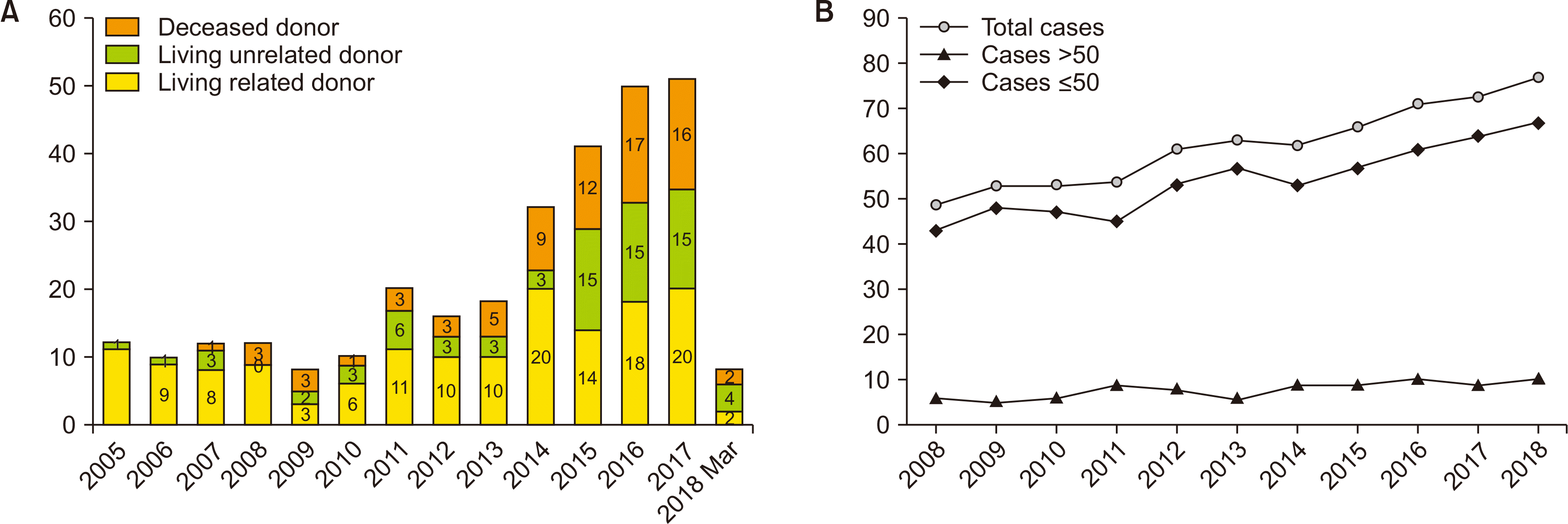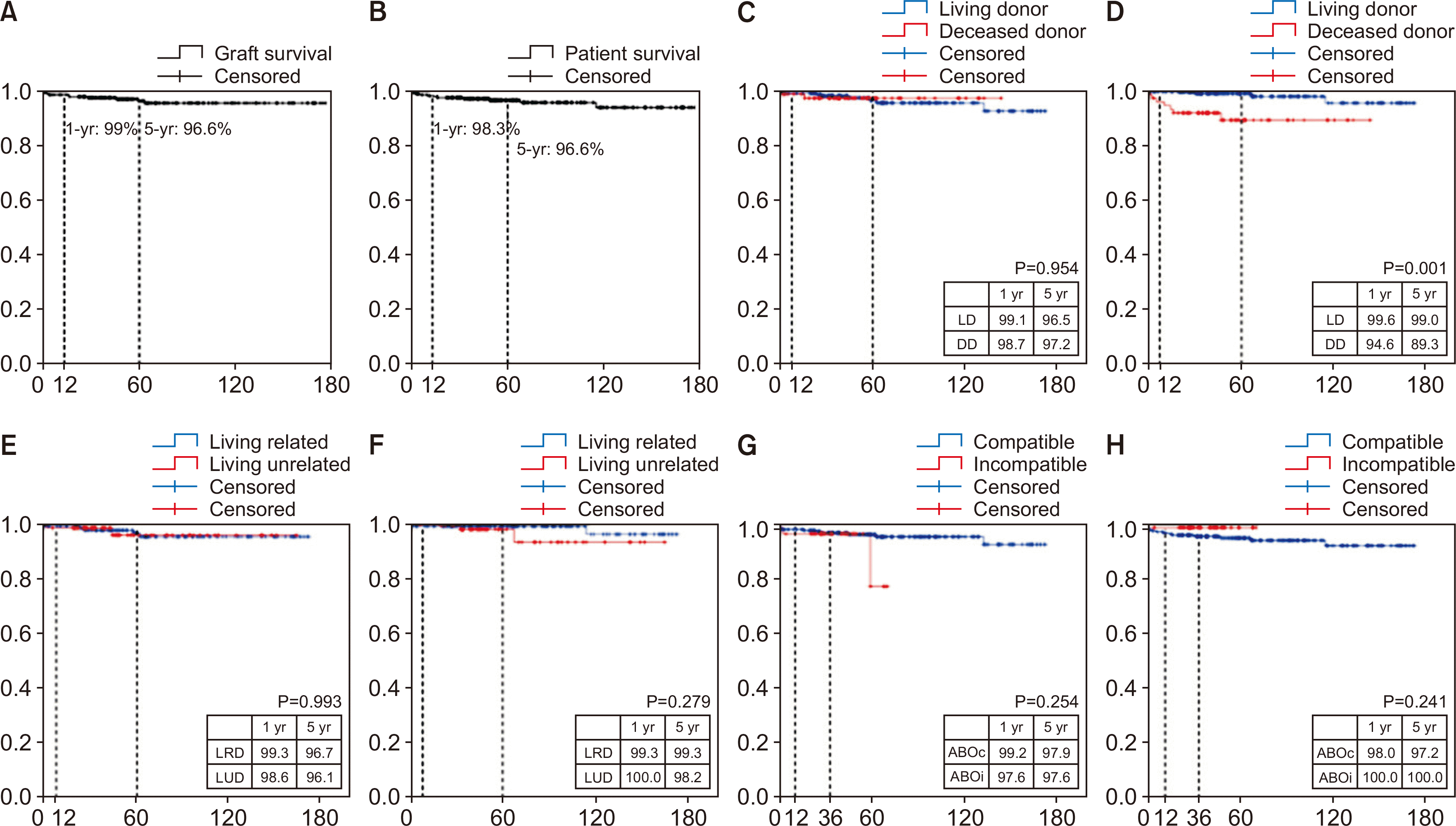1. Korean Network for Organ Sharing (KONOS). 2019. 2018 Annual data report [Internet]. KONOS;Seoul: Available from:
http://konos.go.kr. cited 2020 Aug 10.
2. Hill NR, Fatoba ST, Oke JL, Hirst JA, O'Callaghan CA, Lasserson DS, et al. 2016; Global prevalence of chronic kidney disease: a systematic review and meta-analysis. PLoS One. 11:e0158765. DOI:
10.1371/journal.pone.0158765. PMID:
27383068.
3. Ahn C, Koo TY, Jeong JC, Kim M, Yang J, Lee J, et al. 2014; Initial report of the Korean Organ Transplant Registry: the first report of national kidney transplantation data. Transplant Proc. 46:425–30. DOI:
10.1016/j.transproceed.2013.11.083. PMID:
24655980.

4. Yang SS, Park JB. 2017; Kidney transplantation from expanded criteria donor in Korea: it's time to have our own criteria based on our experiences. J Korean Soc Transplant. 31:16–24. DOI:
10.4285/jkstn.2017.31.1.16.

5. Wadei HM, Heckman MG, Rawal B, Taner CB, Farahat W, Nur L, et al. 2013; Comparison of kidney function between donation after cardiac death and donation after brain death kidney transplantation. Transplantation. 96:274–81. DOI:
10.1097/TP.0b013e31829807d1. PMID:
23778649.

7. Snoeijs MG, Schaubel DE, Hené R, Hoitsma AJ, Idu MM, Ijzermans JN, et al. 2010; Kidneys from donors after cardiac death provide survival benefit. J Am Soc Nephrol. 21:1015–21. DOI:
10.1681/ASN.2009121203. PMID:
20488954. PMCID:
PMC2900965.

8. Kim SK, Park JH, Yoon SA, Yang CW, Jin DC, Kim SY, et al. 2001; Clinical analysis on 200 cases of kidney transplantation in a single center. J Korean Soc Transplant. 15:183–8.
9. Kim JS, Kim HT, Cho WH, Park SB, Kim HC, Park CH, et al. 2001; Single center experience of 500 consecutive renal transplantation. J Korean Soc Transplant. 15:8–12.
10. Hong JW, Shin MJ, Moon HH, Lee SH, Kim JM, Park JB, et al. 2014; Analysis of 1,500 kidney transplantations at Sungkyunkwan University. J Korean Soc Transplant. 28:25–35. DOI:
10.4285/jkstn.2014.28.1.25.

11. Heo Y, Park HS, Shin CS, Yoo KC, Kim D, Lee T. 2019; Successful treatment of life-threatening small bowel bleeding with thalidomide after living donor kidney transplantation: a case report. Transplant Proc. 51:3092–8. DOI:
10.1016/j.transproceed.2019.07.009. PMID:
31623898.

12. Drognitz O, Donauer J, Kamgang J, Baier P, Neeff H, Lohrmann C, et al. 2007; Living-donor kidney transplantation: the Freiburg experience. Langenbecks Arch Surg. 392:23–33. DOI:
10.1007/s00423-006-0074-0. PMID:
16924533.

13. Kwon OJ, Kim YH, Ahn BK, Kang CM, Kwak JY. 2005; Long-term graft outcome of living donor renal transplantation: single center experience. Transplant Proc. 37:690–2. DOI:
10.1016/j.transproceed.2004.11.039. PMID:
15848503.

14. Terasaki PI, Cecka JM, Gjertson DW, Takemoto S. 1995; High survival rates of kidney transplants from spousal and living unrelated donors. N Engl J Med. 333:333–6. DOI:
10.1056/NEJM199508103330601. PMID:
7609748.

15. Roozbeh J, Mehdizadeh AR, Izadfar MA, Razmkon A, Salahi H, Malek-Hosseini SA. 2006; Comparison of spousal with other donor groups: study of a single center. Transplant Proc. 38:562–3. DOI:
10.1016/j.transproceed.2005.12.058. PMID:
16549175.

16. Tang S, Lui SL, Lo CY, Lo WK, Cheng IK, Lai KN, et al. 2004; Spousal renal donor transplantation in Chinese subjects: a 10 year experience from a single centre. Nephrol Dial Transplant. 19:203–6. DOI:
10.1093/ndt/gfg492. PMID:
14671058.

17. Kosoku A, Uchida J, Nishide S, Kabei K, Shimada H, Iwai T, et al. 2018; Dec. 31. ABO-incompatible kidney transplantation as a renal replacement therapy: a single low volume center experience in Japan. PLoS One. [Epub]. DOI:
10.1371/journal.pone.0208638. PMID:
30596663.
18. Shin E, Kwon SW, Yang WS, Baeck C, Yu H, Cho H, et al. 2015; Long-term outcomes of ABO-incompatible living donor kidney transplantation: a comparative analysis. Transplant Proc. 47:1720–6. DOI:
10.1016/j.transproceed.2015.05.026. PMID:
26293040. PMCID:
PMC7238598.

19. Scurt FG, Ewert L, Mertens PR, Haller H, Schmidt BM, Chatzikyrkou C. 2019; Clinical outcomes after ABO-incompatible renal transplantation: a systematic review and meta-analysis. Lancet. 393:2059–72. DOI:
10.1016/S0140-6736(18)32091-9. PMID:
31006573.

20. Williams RC, Opelz G, McGarvey CJ, Weil EJ, Chakkera HA. 2016; The risk of transplant failure with HLA mismatch in first adult kidney allografts from deceased donors. Transplantation. 100:1094–102. DOI:
10.1097/TP.0000000000001115. PMID:
26901078. PMCID:
PMC5441983.

21. Williams RC, Opelz G, Weil EJ, McGarvey CJ, Chakkera HA. 2017; The risk of transplant failure with HLA mismatch in first adult kidney allografts 2: living donors, summary, guide. Transplant Direct. 3:e152. DOI:
10.1097/TXD.0000000000000664. PMID:
28573187. PMCID:
PMC5441983.

22. Nicholson ML, Windmill DC, Horsburgh T, Harris KP. 2000; Influence of allograft size to recipient body-weight ratio on the long-term outcome of renal transplantation. Br J Surg. 87:314–9. DOI:
10.1046/j.1365-2168.2000.01390.x. PMID:
10718800.

23. Giral M, Foucher Y, Karam G, Labrune Y, Kessler M, Hurault de Ligny B, et al. 2010; Kidney and recipient weight incompatibility reduces long-term graft survival. J Am Soc Nephrol. 21:1022–9. DOI:
10.1681/ASN.2009121296. PMID:
20488949. PMCID:
PMC2900958.

24. Eo SH, Lee SH, Won JH, Oh CK. 2015; Impact of graft kidney volume and weight on graft function in living donor kidney transplantation. J Korean Soc Transplant. 29:209–15. DOI:
10.4285/jkstn.2015.29.4.209.

25. Pourmand G, Salem S, Mehrsai A, Taherimahmoudi M, Ebrahimi R, Pourmand MR. 2007; Infectious complications after kidney transplantation: a single-center experience. Transpl Infect Dis. 9:302–9. DOI:
10.1111/j.1399-3062.2007.00229.x. PMID:
17511823. PMCID:
PMC7361238.

26. Yoo YS, Park HS, Oh SW, Chae DW, Lee TS. 2012; Clinical manifestations of BK virus infection in kidney transplant recipients: a single center experience. J Korean Soc Transplant. 26:23–31. DOI:
10.4285/jkstn.2012.26.1.23.

28. Hirsch HH, Knowles W, Dickenmann M, Passweg J, Klimkait T, Mihatsch MJ, et al. 2002; Prospective study of polyomavirus type BK replication and nephropathy in renal-transplant recipients. N Engl J Med. 347:488–96. DOI:
10.1056/NEJMoa020439. PMID:
12181403.

29. Bohl DL, Brennan DC. 2007; BK virus nephropathy and kidney transplantation. Clin J Am Soc Nephrol. 2 Suppl 1:S36–46. DOI:
10.2215/CJN.00920207. PMID:
17699509.







 PDF
PDF Citation
Citation Print
Print



 XML Download
XML Download